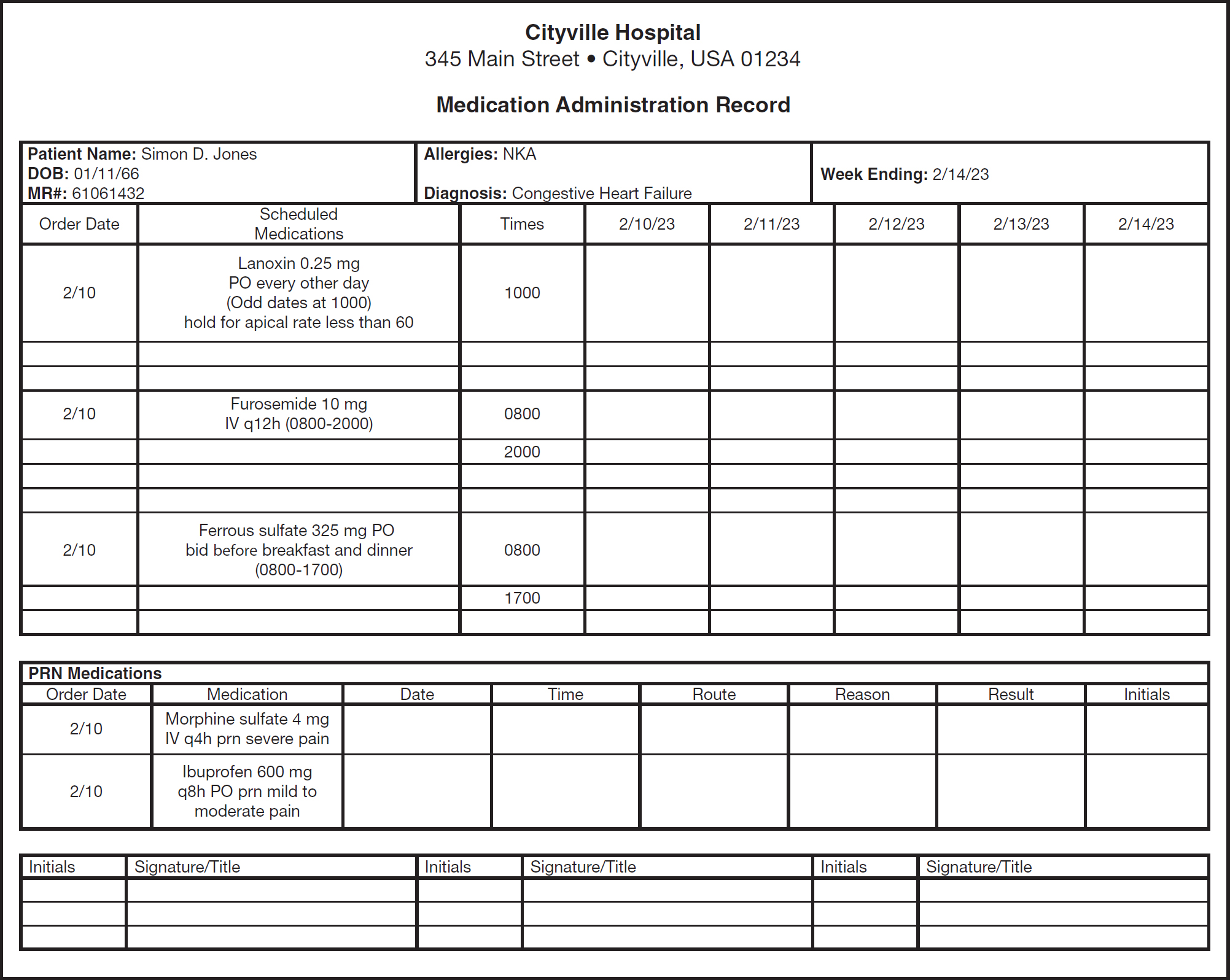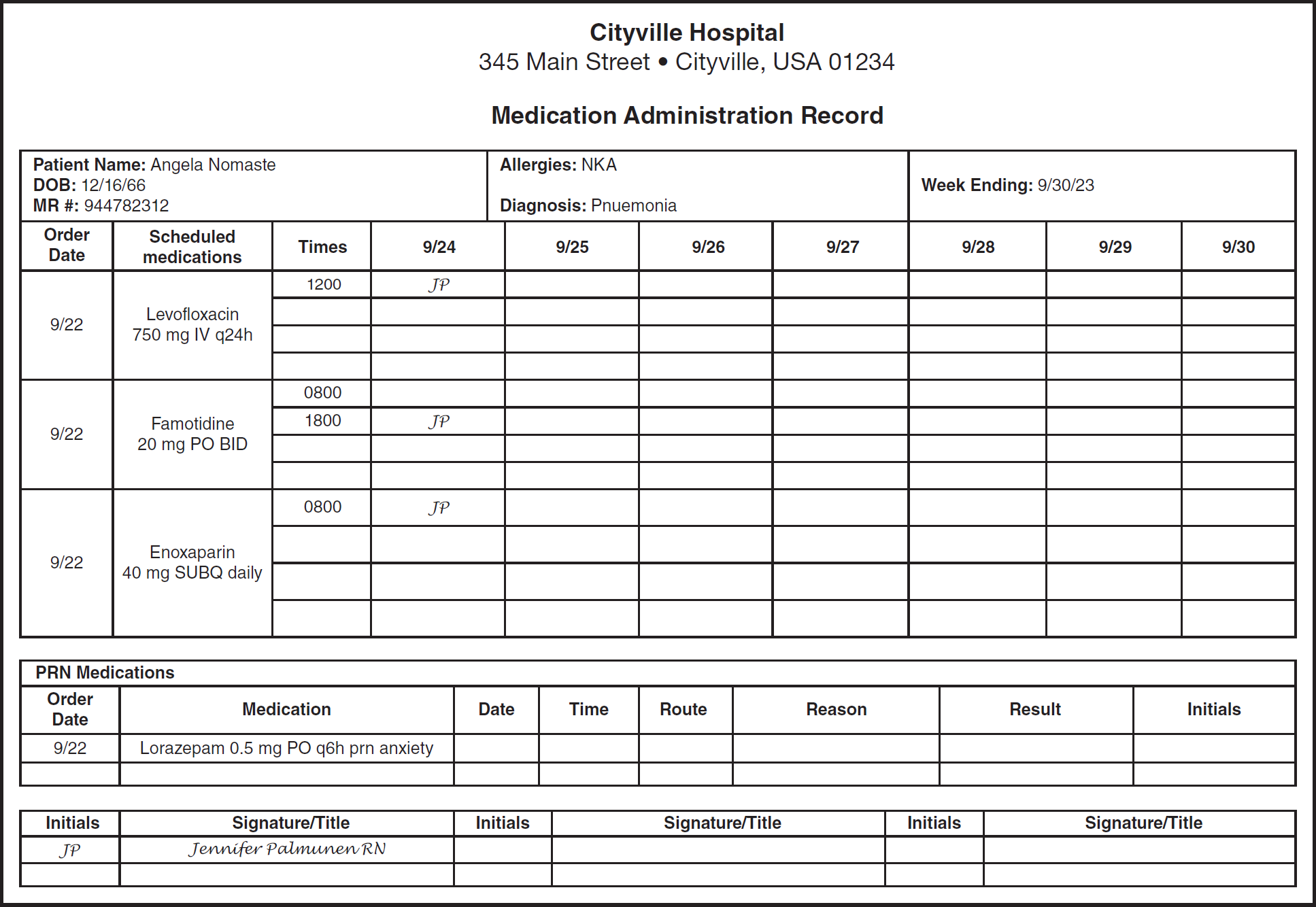Medication administration records (MARs) are legal records that contain the same information as the medication order with the addition of the specified times for administration. After an order is generated electronically, it is (typically automatically) uploaded to a special form within the patient's electronic medical record that is used for documentation of drugs given to the patient and is called the electronic medication administration record (eMAR). Handwritten medication orders are manually entered onto the eMAR or transcribed onto a paper MAR according to agency protocol for transcription of medication orders. Transcription is the process of copying or entering orders onto the MAR or eMAR and includes the assignment of times for administration. The person responsible for transcription depends upon agency policy and may be a nurse, pharmacist, secretary, or pharmacy technician. Figure 4-5 depicts the transcription of the medication orders from the form in Figure 4-4 onto a MAR, while Figure 4-6 shows orders on an eMAR.
This MAR indicates that ampicillin was given at 0600, gentamicin was administered at 0800, and acetaminophen was given at 1000 by Sharon Schultz, RN, on January 8.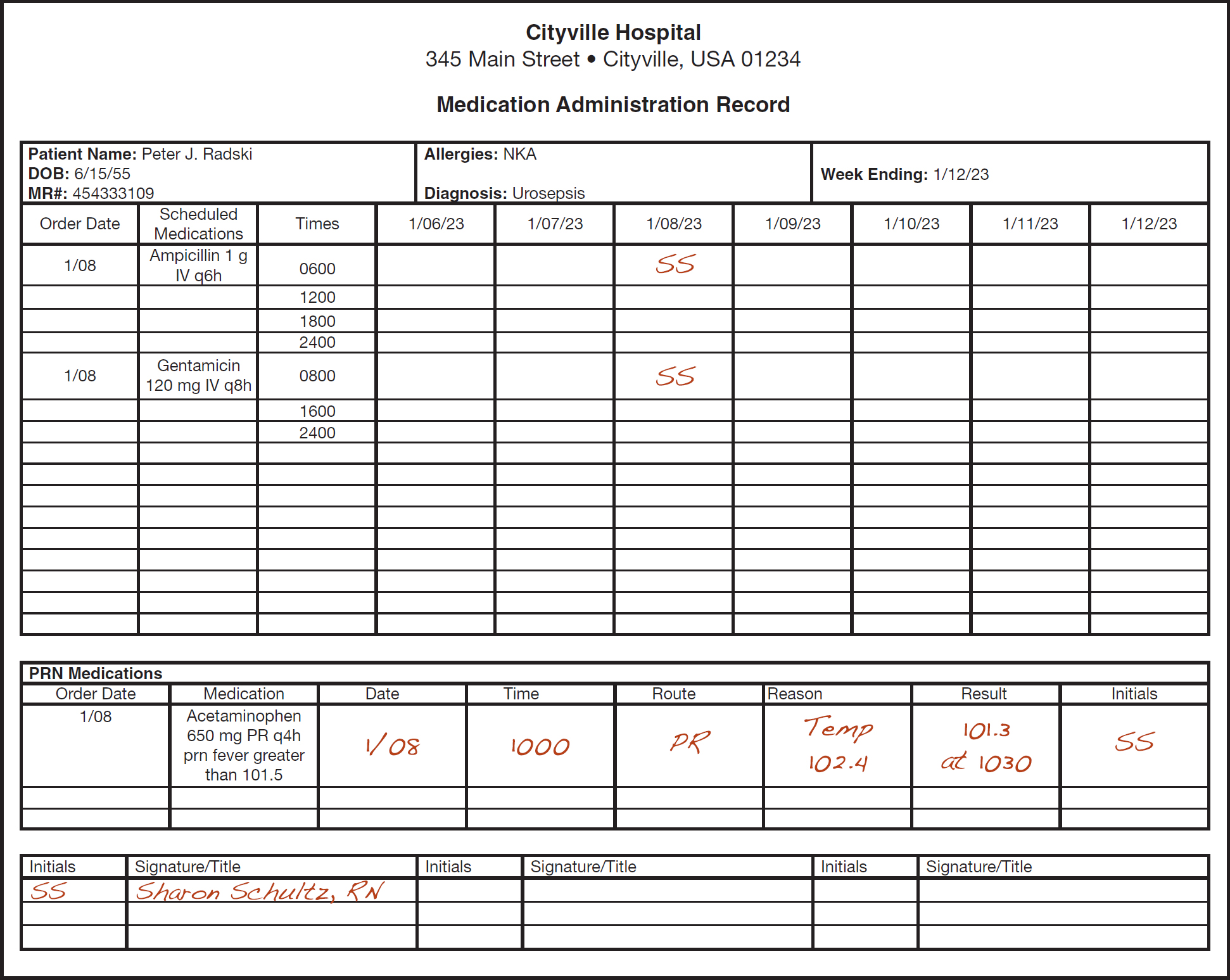
A medication administration record of Cityville Hospital.
The form depicts the address of Cityville Hospital at the top center, name, date of birth, M R number, diagnosis, allergies, and week ending date below them. Below it, a blank table depicts order date, scheduled medications, times, 1 forward slash 06 2023, 1 forward slash 07 2023, 1 forward slash 08 2023, 1 forward slash 09 2023, 1 forward slash 10 2023, 1 forward slash 11 2023, and 1 forward slash 12 2023. Row 1. Order date: 1 forward slash 08. Scheduled medications: Ampicillin 1 gram I V q 6 h. Times: 0600, 1200, 1800, 2400. 1 forward slash 08 2023: S S. Row 2. Order date: 1 forward slash 08. Scheduled medications: Gentamicin 120 milligrams I V q 8 h. Times: 0800, 1600, 2400. 1 forward slash 08 2023: S S. Below it, a blank table for P R N medications depicts Order Date, Medication, Date, Time, Route, Reason, Result, Initials. Row 1. 1 forward slash 08, Acetaminophen 650 milligrams P R q 4 h p r n fever greater than 101.5, 1 forward slash 08, 1000, P R, Temp 102.4, 101.3 at 1030, S S. Below it, a blank table depicts Initials, Signature or Title, Initials, Signature or Title, Initials, Signature or Title. Row 1. Initials: S s. Signature or Title: Sharon Schultz, R N.
To access details regarding the administration of furosemide on the eMAR, such as the name of the individual who administered the medication or the patient's blood pressure at the time of administration, the user hovers the mouse over the identified site on the eMAR.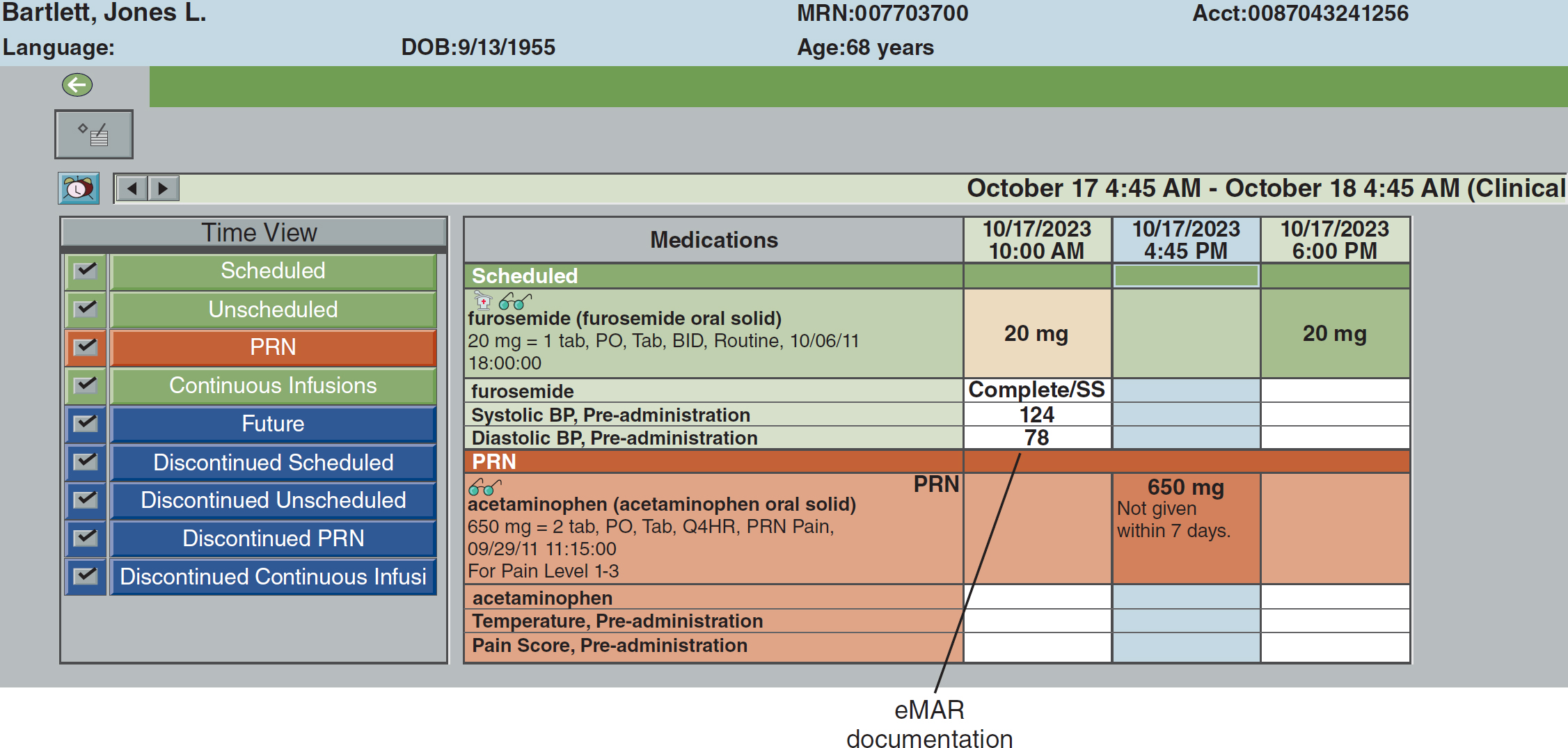
A medication order of Bartlett, Jones L.
The order reads, M R N: 007703700, Account: 0087043241256, blank space for language, date of birth: 9 forward slash 13 forward slash 1955, and age 68 years. Below it, the date and time are as October 17, 4:45 A M to October 18, 8:45 A M. The left panel depicts selected check boxes for scheduled, unscheduled, P R N, continuous infusions, future, discontinued scheduled, discontinued unscheduled, discontinued P R N, discontinued continuous infusion under time view. The right panel depicts a table with 4 columns. The column headers read: Medications, 10 forward slash 17 forward slash 2023 10:00 A M, 10 forward slash 17 forward slash 2023 4:45 P M, and 10 forward slash 17 forward slash 2023 6:00 P M. The upper section of the table is labeled, Scheduled and comprises 4 rows. The lower section is labeled P R N and comprises 4 rows. Row 1 reads, furosemide, furosemide oral solid, 20 milligrams equals 1 tablet, P O, Tablet, B I D, Routine, 10 forward slash 06 forward slash 11, 18:00:00, 20 milligrams, blank space, 20 milligrams. Row 2 reads, furosemide, Complete forward slash SS, blank space, blank space. Row 3 reads, Systolic B P, Pre-administration, 124, blank space, blank space. Row 4 reads, Diastolic B P, Pre-administration, 78, blank space, blank space. Row 5 reads, acetaminophen, acetaminophen oral solid, 650 milligrams equals 2 tablets, P O, Tablet, Q 4 H R, P R N Pain, 09 forward slash 29 forward slash 11 11:15:00 For Pain Level 1 to 3, blank space, 650 milligrams not given within 7 days, blank space. Row 5 reads, acetaminophen, blank space, blank space, blank space. Row 6 reads, Temperature, Pre-administration, blank space, blank space, blank space. Row 5 reads, Pain Score, blank space, blank space, blank space. Note: e M A R documentation points to 78.
As shown in Figures 4-5 and 4-6, the MAR/eMAR provides a place for documentation of medications given.
LEARNING ACTIVITY 4-5 Complete the MAR for Kevin Dunbar, depicted in Figure 4-7, as follows:
Medication administration record (MAR) to be completed for Kevin Dunbar (see Learning Activity 4-5).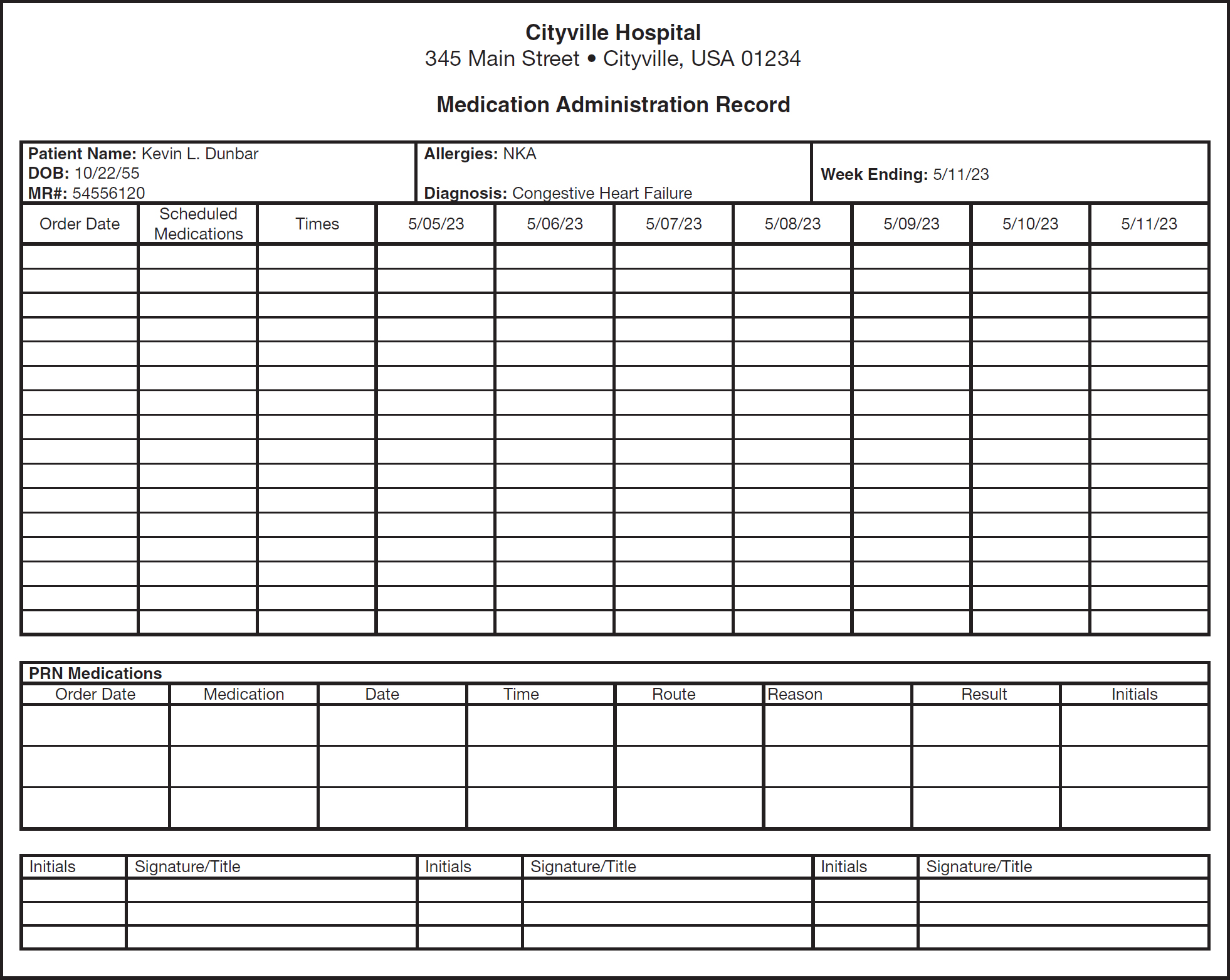
A medication administration record of Cityville Hospital.
The form depicts the address of Cityville Hospital at the top center, name, date of birth, M R number, diagnosis, allergies, and week ending date below them. Below it, a blank table depicts order date, scheduled medications, times, 1 forward slash 06 forward slash 19, 1 forward slash 07 forward slash 19, 1 forward slash 08 forward slash 19, 1 forward slash 09 forward slash 19, 1 forward slash 10 forward slash 19, 1 forward slash 11 forward slash 19, and 1 forward slash 12 forward slash 19. Below it, a blank table for P R N medications depicts Order Date, Medication, Date, Time, Route, Reason, Result, Initials. Below it, a blank table depicts Initials, Signature or Title, Initials, Signature or Title, Initials, Signature or Title.
1. Enter this medication ordered on 5/5: heparin 5,000 units SUBQ q12h (0800, 2000).
2. Enter this medication ordered on 5/6: Maalox 30 mL via GT q6h (0600, 1200, 1800, 2400).
3. Sign the medication sheet with your initials as if you had given the medications on the day shift (0700–1500) on 5/8.
Order Error … Case ClosureAdministration of multiple doses of Tylenol instead of the single dose that was intended resulted in delays in evaluation and treatment. Delaying evaluation of the cause of this child's fever and resulting treatment delays could have adverse effects. When taking telephone orders, the nurse should:
The nurse should have questioned the medical doctor (MD) regarding frequency. Had the nurse asked, "Did you want the Tylenol given q4h prn fever greater than 101?" as was presumed, the physician would then have clarified that it was to be a single-dose order. Then the nurse should have recited back the order back for verification, saying something like, "Oh, so you want Tylenol 325 mg PO now one time only and notify MD for persistent fever … is that right?" The MD would then reply, "Yes, that's correct!" This exchange reveals that the nurse correctly interpreted the order. |




